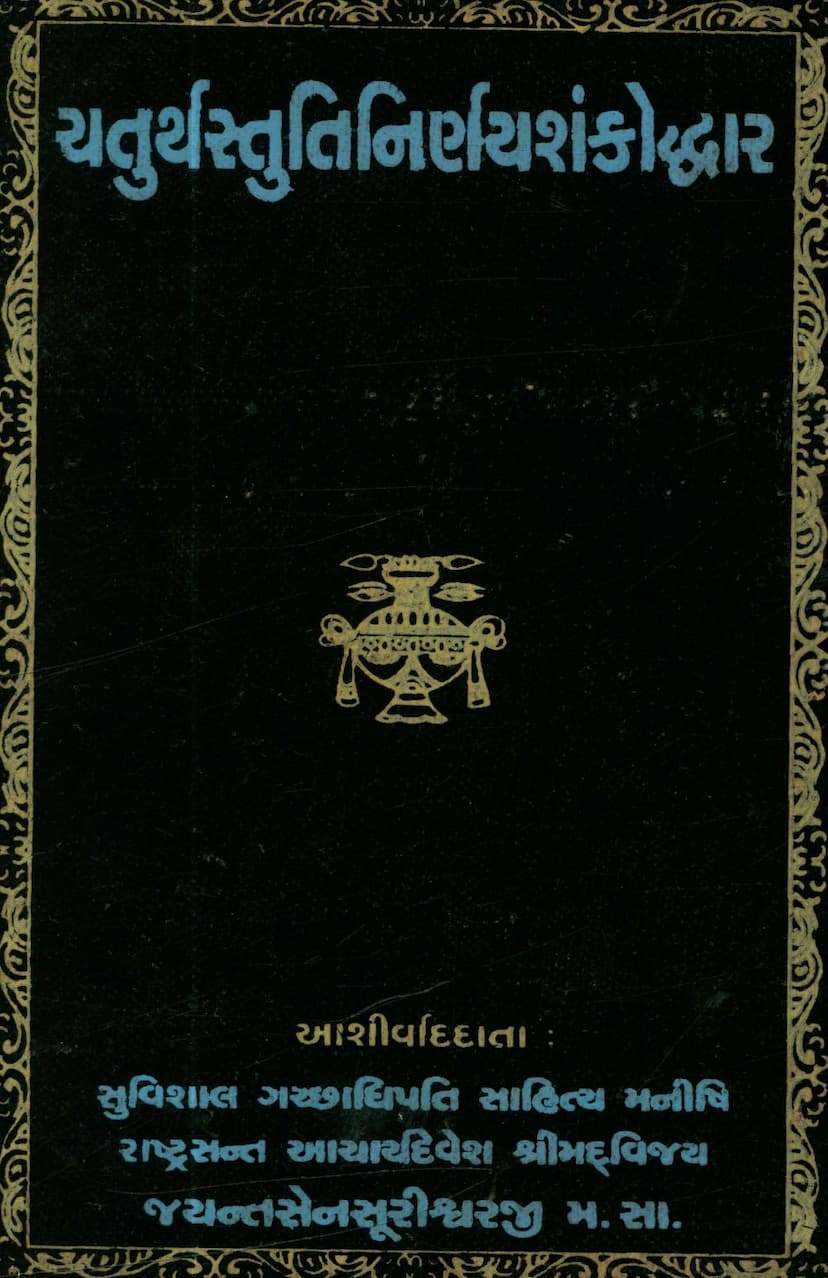Chaturthstutinirnay Shankoddhar
Added to library: September 1, 2025

Summary
Certainly! Here's a comprehensive summary of the Jain text "Chaturthstutinirnay Shankoddhar" by Dhanvijaymuni, based on the provided pages.
Title: Chaturthstutinirnay Shankoddhar (also known as Chaturthstutikuyuktininay Chhedankuthar)
Author: Pandit Muni Dhanvijayji Maharaj, disciple of Acharya Devesh Shrimad Vijay Rajendrasuriji M.S.
Publisher: Shri Saudharm Bruhat Tapogacchiya Tristutik Jain Shwetambar Sangh
Overview:
This book, "Chaturthstutinirnay Shankoddhar," is a critical examination and refutation of the controversial viewpoints presented in a text titled "Chaturthstutinirnay" authored by Atmaramji (alias Anandvijayji). The central aim of this work is to uphold the authentic teachings and practices of Jainism, as established by the Tirthankaras and propagated by the ancient Āchāryas. The author, Muni Dhanvijayji, through this text, aims to correct what he considers to be deviations and misinterpretations that have crept into Jain practices, particularly concerning the number of stutis (acts of reverence or praise) during Pratikraman (a ritual of confession and atonement).
Key Themes and Arguments:
-
Refutation of Atmaramji's "Chaturthstutinirnay": The primary motivation for writing this book is to counter the claims made by Atmaramji in his "Chaturthstutinirnay." Atmaramji is accused of rejecting the traditional tin thoi (three ways of reverence) followed by the lineage of former Āchāryas and advocating for a chauthi thoi (fourth way of reverence) during Pratikraman. Muni Dhanvijayji asserts that this deviation is against the established Jain Agamas and the practices of the Pūrvadhar Āchāryas.
-
Historical Discrepancies and Accusations of Falsehood: The author thoroughly dissects Atmaramji's claims, particularly those made in the preface of his book. He specifically targets Atmaramji's alleged misrepresentation of historical events concerning Acharya Vijay Rajendra Suriji and his interactions with Vijay Dharanendra Suri. Muni Dhanvijayji provides evidence, such as a "nine-clause agreement letter" and a copper plate inscription, to prove Atmaramji's statements false and driven by ulterior motives (like increasing personal worship and recognition).
-
Emphasis on Scriptural Authority and Pūrvadhar Practices: The book heavily relies on the authority of ancient Jain scriptures and the lineage of Pūrvadhar Āchāryas. Muni Dhanvijayji emphasizes that any practice or belief that contradicts the Agamas or the established traditions of the Pūrvadharas is incorrect. He meticulously quotes from various Jain scriptures like Agamashtottarika, Anuyogdwar, Bhagavati Sutra, Sthananga Sutra, Nishith Sutra, Brihatkalpa Bhashya, Darshan Shuddhi, and many others to support his arguments.
-
Debate on "Thoi" (Modes of Reverence): A significant portion of the text is dedicated to clarifying the correct number and practice of stutis (thoi) in Jain rituals, especially during Pratikraman and Chaitya Vandan (worship of Jina images). The author strongly defends the traditional tin thoi (three modes) and refutes Atmaramji's advocacy for chauthi thoi (fourth mode) as a misinterpretation and violation of scriptural teachings.
-
Gurus and Lineage (Gachha Parampara): The book delves into the importance of the Guru-disciple lineage (Gachha Parampara) and the proper adherence to the teachings transmitted through it. It highlights historical instances of Āchāryas re-initiating themselves or following the path of earlier Āchāryas to uphold the purity of the lineage and practices, as seen in the case of Vijay Rajendra Suriji. The text also meticulously traces the lineage of the author's own Guru, Acharya Vijay Rajendra Suriji, emphasizing his adherence to scriptural guidelines and the concept of Kriyoddhar (restoration of pure conduct).
-
Critique of Atmaramji's Character and Motives: Beyond refuting the doctrinal points, Muni Dhanvijayji also engages in a critique of Atmaramji's character, accusing him of being prideful, spreading falsehoods, deviating from scriptural practices (like wearing yellow clothes), and ultimately seeking personal glory. The author asserts that Atmaramji's deviations are driven by ego and a desire for self-aggrandizement, which are detrimental to the true Jain path.
-
Importance of Purity of Conduct and Intent: The book repeatedly stresses the significance of pure conduct (Achara Shuddhi) and correct intentions (Bhava Shuddhi) in following Jain principles. It criticizes practices that are not supported by scriptures or are based on personal interpretations rather than established traditions.
-
Reinterpretation of Scriptures and the Concept of "Thoi": The author systematically analyzes the scriptures cited by Atmaramji to demonstrate how they have been misinterpreted. He explains the context and correct application of verses related to Chaitya Vandan and Pratikraman, emphasizing that the traditional tin thoi is supported by the Agamas for specific rituals, while chauthi thoi might be applicable in specific ceremonial contexts (Pūjā, Pratishthā) but not universally or during Pratikraman itself.
Purpose and Significance:
The "Chaturthstutinirnay Shankoddhar" serves as a defense of the orthodox Jain tradition, specifically the Shwetambar tradition represented by the Tapagachha lineage. It aims to guide the followers of Jainism, particularly the laity (Shravakas), towards correct understanding and practice by clarifying scriptural interpretations and exposing what the author perceives as heresies and deviations propagated by Atmaramji. The book is a scholarly work that seeks to preserve the sanctity and integrity of Jain teachings for future generations.
In essence, the book is a detailed scriptural and logical defense of traditional Jain practices against what the author considers to be erroneous interpretations and innovations introduced by Atmaramji, emphasizing the paramount importance of adhering to the Agamas and the teachings of the ancient Āchāryas.